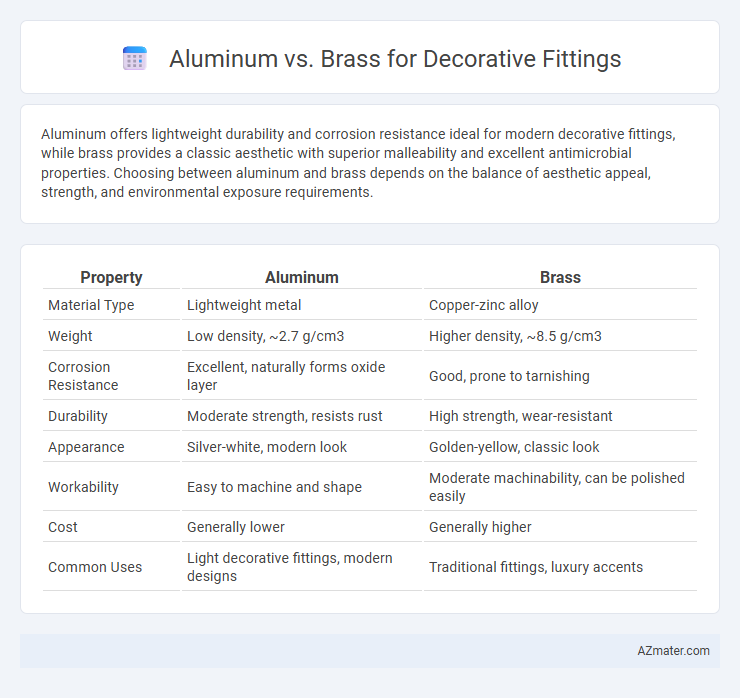Aluminum offers lightweight durability and corrosion resistance ideal for modern decorative fittings, while brass provides a classic aesthetic with superior malleability and excellent antimicrobial properties. Choosing between aluminum and brass depends on the balance of aesthetic appeal, strength, and environmental exposure requirements.
Table of Comparison
| Property | Aluminum | Brass |
|---|---|---|
| Material Type | Lightweight metal | Copper-zinc alloy |
| Weight | Low density, ~2.7 g/cm3 | Higher density, ~8.5 g/cm3 |
| Corrosion Resistance | Excellent, naturally forms oxide layer | Good, prone to tarnishing |
| Durability | Moderate strength, resists rust | High strength, wear-resistant |
| Appearance | Silver-white, modern look | Golden-yellow, classic look |
| Workability | Easy to machine and shape | Moderate machinability, can be polished easily |
| Cost | Generally lower | Generally higher |
| Common Uses | Light decorative fittings, modern designs | Traditional fittings, luxury accents |
Introduction to Decorative Fittings
Decorative fittings enhance the aesthetic appeal and functionality of furniture, doors, and interiors by combining design with durability. Aluminum offers lightweight strength, corrosion resistance, and a modern finish ideal for sleek, contemporary designs. Brass provides a classic, warm appearance with excellent malleability and natural antimicrobial properties, favored for traditional and vintage styles.
Key Properties of Aluminum
Aluminum offers lightweight durability, corrosion resistance, and excellent malleability, making it ideal for intricate decorative fittings. Its resistance to rust ensures long-lasting aesthetic appeal in both indoor and outdoor applications. Aluminum's natural silver finish also provides a modern look that can be anodized for enhanced surface protection and color options.
Key Properties of Brass
Brass offers superior corrosion resistance, making it ideal for decorative fittings exposed to moisture or outdoor elements. Its natural antimicrobial properties enhance hygiene, often preferred in applications like door handles and fixtures. Additionally, brass's excellent malleability allows for intricate designs and a polished, warm golden appearance that enhances aesthetic appeal.
Aesthetic Differences: Aluminum vs Brass
Aluminum offers a modern, sleek appearance with a smooth, matte or brushed finish that complements contemporary decor styles, while brass provides a warm, rich golden hue that adds a classic, vintage charm to decorative fittings. Brass naturally develops a patina over time, enhancing its antique aesthetic, whereas aluminum maintains its original look without significant color change. The choice between aluminum and brass depends on whether a cool, minimalist design or a traditional, ornate style is desired for the decorative element.
Durability and Longevity Comparison
Aluminum offers excellent corrosion resistance and lightweight properties, making it durable for outdoor and humid environments without rusting or tarnishing. Brass, composed primarily of copper and zinc, provides superior strength and a naturally antimicrobial surface, which enhances its longevity and resistance to wear in high-contact applications. While brass tends to develop a patina over time, aluminum maintains its original appearance longer when properly coated or anodized, ensuring lasting decorative appeal.
Maintenance and Care Requirements
Aluminum decorative fittings require minimal maintenance due to their natural oxide layer that resists corrosion and tarnish, needing only occasional cleaning with mild soap and water. Brass fittings demand more regular upkeep to prevent oxidation and patina development, often requiring polishing with brass-specific cleaners to maintain their shine. Choosing aluminum reduces long-term maintenance efforts, while brass offers a classic aesthetic at the cost of more frequent care.
Cost Analysis: Aluminum vs Brass
Aluminum fittings typically cost 30-50% less than brass due to lower raw material and manufacturing expenses, making aluminum a budget-friendly choice for decorative applications. Brass, composed of copper and zinc, commands higher prices because of costly metal components and complex casting processes, resulting in increased overall expense. Despite aluminum's affordability, brass offers superior durability and aesthetic appeal, often justifying its higher initial investment in premium decorative fittings.
Environmental Impact and Sustainability
Aluminum offers significant environmental advantages over brass in decorative fittings due to its high recyclability rate and lower energy consumption during production, reducing carbon emissions by up to 95% compared to primary aluminum extraction. Brass, composed primarily of copper and zinc, involves mining processes that have higher ecological footprints, including habitat disruption and heavier water usage. Choosing aluminum fittings supports sustainability goals by promoting circular economy practices and minimizing resource depletion.
Popular Applications in Interior Design
Aluminum and brass both excel in decorative fittings, with aluminum favored for modern, minimalist interiors due to its lightweight, corrosion-resistant properties and sleek metallic finish. Brass, known for its warm golden hue and durability, is popular in classic and vintage-inspired designs, often used in handles, knobs, and light fixtures to add an elegant, timeless touch. Interior designers select aluminum for contemporary aesthetics and brass for rich, traditional accents, tailoring choices to project style and functional needs.
Choosing the Right Material for Your Project
Aluminum offers lightweight durability and corrosion resistance, making it ideal for modern decorative fittings exposed to moisture or outdoor conditions. Brass provides a classic, warm aesthetic with excellent machinability and natural antimicrobial properties, suitable for high-end or traditional designs. Selecting the right material depends on factors like environmental exposure, desired finish, strength requirements, and budget constraints.

Infographic: Aluminum vs Brass for Decorative Fitting
 azmater.com
azmater.com